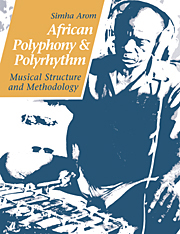Book contents
- Frontmatter
- Contents
- List of illustrations
- Foreword by György Ligeti
- Preface
- Acknowledgements
- BOOK I THE MUSIC OF THE CENTRAL AFRICAN REPUBLIC
- BOOK II AFRICAN POLYPHONIC MUSIC
- BOOK III TECHNICAL TOOLS: METHODS OF RECORDING POLYPHONIC MUSIC FOR TRANSCRIPTION
- 1 The need for transcription
- 2 The difficulties of transcription
- 3 Earlier methods
- 4 Towards a new method
- 5 Theoretical assumptions
- 6 Technical equipment: description and use
- 7 From recording to transcription
- 8 Checking the results
- 9 Potentialities
- 10 Anthropological validity
- BOOK IV THEORETICAL TOOLS
- BOOK V THE ORGANISATION OF TIME IN AFRICAN MUSIC
- BOOK VI STRUCTURAL PRINCIPLES AND THEIR APPLICATION
- Conclusion
- Bibliography
3 - Earlier methods
Published online by Cambridge University Press: 27 January 2010
- Frontmatter
- Contents
- List of illustrations
- Foreword by György Ligeti
- Preface
- Acknowledgements
- BOOK I THE MUSIC OF THE CENTRAL AFRICAN REPUBLIC
- BOOK II AFRICAN POLYPHONIC MUSIC
- BOOK III TECHNICAL TOOLS: METHODS OF RECORDING POLYPHONIC MUSIC FOR TRANSCRIPTION
- 1 The need for transcription
- 2 The difficulties of transcription
- 3 Earlier methods
- 4 Towards a new method
- 5 Theoretical assumptions
- 6 Technical equipment: description and use
- 7 From recording to transcription
- 8 Checking the results
- 9 Potentialities
- 10 Anthropological validity
- BOOK IV THEORETICAL TOOLS
- BOOK V THE ORGANISATION OF TIME IN AFRICAN MUSIC
- BOOK VI STRUCTURAL PRINCIPLES AND THEIR APPLICATION
- Conclusion
- Bibliography
Summary
Four techniques have been proposed to solve the problems of transcribing complex polyphonic phenomena. All of them require, for one reason or another, that the investigator spend time in the field. The first is propounded by the American school following Mantle Hood, and is called performing. It involves learning how to play traditional music and using the knowledge acquired in this way to transcribe it. The second requires the kind of special technical equipment developed by A. M. Jones for his own use. The third involves the use of films, which may be either silent or synchronised with a sound track. These are subjected to frame-by-frame analysis. The fourth and last consists of a special use of conventional stereophonic sound recording equipment to obtain a measure of separation of the parts in the polyphonic whole.
We will now discuss each of these techniques in turn and point out what we take to be their individual advantages and drawbacks.
PERFORMING
As we have said, this technique involves learning to play an instrument used to perform the music under study, and using the acquired knowledge as a basis for analysis. In the preceding Book, we noted that Gerhard Kubik (1964a) recommends this method. He advises the investigator to get advanced knowledge of how to play an instrument from the traditional musicians in their own cultural setting. Kubik himself followed this procedure in studying the xylophone in Uganda and the harp in the Central African Republic. Mantle Hood, who first propounded this method, has, of course, also used it. In The Ethnomusicologist (1971: 235–7), he describes how he went about learning drum formulae from an Ewe master drummer in Ghana, to gain an understanding of the nature of African polyrhythm.
- Type
- Chapter
- Information
- African Polyphony and PolyrhythmMusical Structure and Methodology, pp. 96 - 103Publisher: Cambridge University PressPrint publication year: 1991



